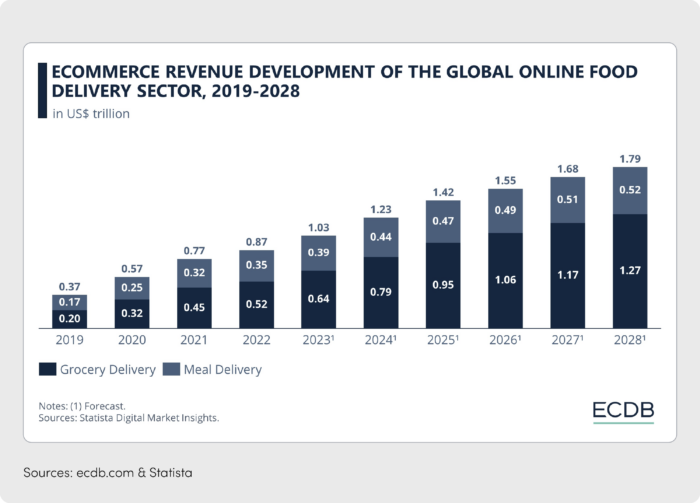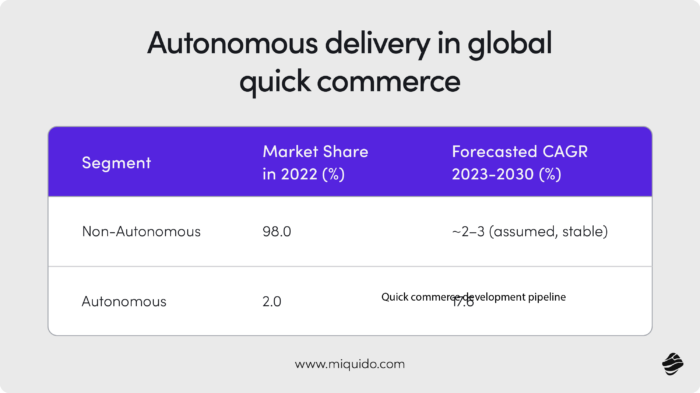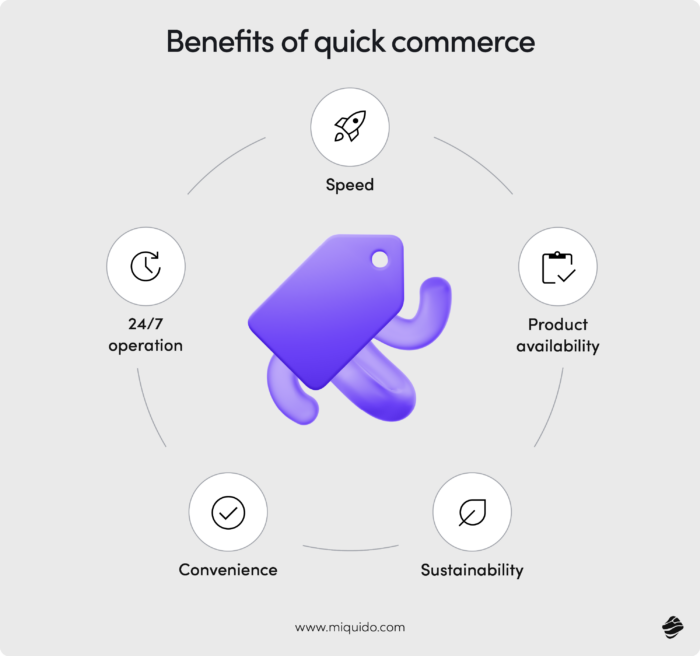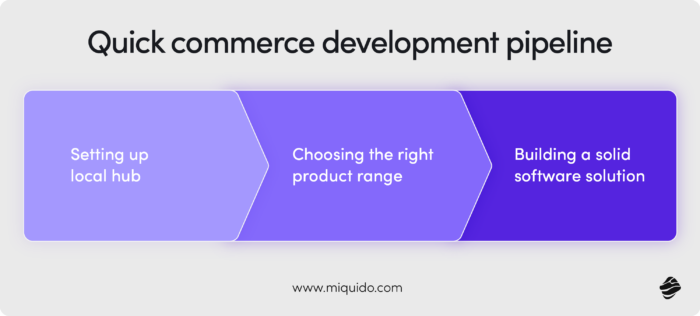As the name suggests, quick commerce (also known as q-commerce or on-demand delivery) consists of delivering online orders to customers ultra-fast and efficiently. Depending on logistics and capacities, such purchases can be delivered to urban customers in 1-2 hours or sometimes even in 15 minutes.
Without a doubt, in quick commerce, food and grocery delivery is an undisputed frontrunner. The numbers speak for themselves – in 2022, we witnessed a 37% increase in online grocery deliveries compared to the previous year. And in the U.S., deliveries reached $3.2 billion in sales in February alone ($0.9 billion more than in 2021).
However, companies are seeing potential in other niches, expanding into new product categories and services. For instance, Glovo has broadened its offer in the recent years, and now users can find games, flowers, and pharmacies in its app – all from nearby local stores. As the company states,
Our mission is to give everyone easy access to anything in their city.
In our article, we delve into the current landscape of quick commerce space and explore how the consumer demand is shaping its development.
Key drivers behind Q-commerce growth
Without a doubt, the outbreak of the COVID-19 pandemic in 2020 was one of the main driving forces behind the rapid development of quick commerce services, which we are still witnessing today. Because of frequent quarantines or supply chain restrictions, customers from around the world shifted towards local businesses that could deliver ordered goods relatively fast.
However, once the restrictions were lifted, q-commerce apps have not lost their momentum. Consumer expectations and habits have changed for good to the point where today, almost half of Americans use rapid delivery for groceries.
Within just a few years, the quick commerce sector has become one of the most important branches of the eCommerce industry, and companies that had previously focused solely on retail or food delivery have begun to adopt a business model based on rapid delivery services.
What caused q-commerce businesses to take off and establish their position in the market so quickly? It comes down to a few key factors that, combined, created fertile ground for the industry’s growth.

Instant gratification drives consumer behavior
Consumers seek instant gratification. Mechanisms reinforced by social media are now influencing other areas of life. When shopping, users want to fulfill their needs as quickly and effortlessly as possible. Combined with the accelerating pace of modern life, this makes online grocery shopping an ideal solution.
Urban density increases the demand for convenience
Urbanization and densely populated cities make everyday shopping increasingly challenging. The light vehicles used in quick commerce help overcome transportation barriers in congested urban environments, which would otherwise cause serious delays. Thanks to this, users don’t have to rely on unreliable public transport to do their shopping after work or before stores close.
Moreover, the strategic placement of dark stores and strategically located warehouses across city neighborhoods ensures fast and localized service.
Technology powers ultra-fast delivery
Ultra-fast delivery services have become possible due to significant advancements in delivery technologies. The first players in the market set the benchmark by rapidly improving functionalities such as delivery route tracking, customer ratings, and real-time inventory management.
Meanwhile, technology for autonomous delivery vehicles has advanced significantly, especially in the United States. While autonomous deliveries currently make up only a small portion of all deliveries, forecasts suggest this could change soon.

Evolution from traditional e-commerce to quick commerce industry
Although quick commerce has its roots in e-commerce, in many ways it has developed its own distinct characteristics – from app functionalities to transaction processing. E-commerce refers to online shopping involving a wide range of goods and services, while q-commerce is limited solely to those with extremely fast delivery times.
Due to ultra-fast deliveries, quick commerce companies had to abandon the inventory management model based on large traditional warehouses outside the city. Companies aiming to deliver goods in less than an hour must build a dense network of micro-fulfillment centers (MFCs) or dark stores located within the city.
Urban logistics and sustainability as strategic advantages
Crucially, these facilities should be strategically placed across various neighborhoods to serve different urban areas effectively. For instance, Glovo ensures ultra-fast delivery of groceries to its users in this way, exemplifying convenient commerce delivery.
Because of its nature, the quick commerce model also becomes inherently more sustainable. Packages ordered traditionally sometimes need to go a long distance by air or road to reach customers, while quick deliveries are most often transported by two-wheeled vehicles like bikes or scooters, thus, in a way more eco-friendly way.
The table below summarises the most significant differences between quick commerce and traditional e-commerce companies:
| q-commerce | traditional e-commerce | |
|---|---|---|
| Delivery speed | 15 minutes to 2 hours | Typically from 2 to 5 days |
| Warehousing | Dark stores inside the city | Large warehouses outside the city |
| Sustainability | Eco-friendly vehicles (bikes, scooters) | Track or air delivery |
The rise of different q-commerce business models: dark stores vs. aggregator-based commerce businesses
In recent years, the growth of quick commerce has accelerated. It began with aggregator-based q-commerce platforms like Uber Eats, which originally focused on restaurant deliveries and then expanded to include supermarket orders.
Soon, new q commerce companies emerged around the world, operating their own dark stores, including Spain’s Glovo, Germany’s Flink, and the US-based Gopuff. Recognizing the future of quick commerce, major retailers have also entered the market with services like Carrefour Sprint, Tesco Whoosh, and Walmart Express Delivery.
An increasing trend is also visible in quick commerce specialization, especially in the US. For instance, companies like Drizly (alcohol) and Petco (pet food and supplies) have decided focusing on niche segments. Despite Drizly being aquired by Uber and ultimately closed down, more businesses follow this path, seeing their chance success in grabbing their specialized piece of a cake. Specialization allows them to stand out in a competitive landscape – they can cater more specifically to the needs of a specific niche, providing it with products they cannot find elsewhere
Benefits of quick commerce
Current consumer preferences make fast delivery services one of the most profitable business models in the grocery commerce industry.
Speed that satisfies and retains
Even just a few years ago, products delivered in 5 working days were totally acceptable. But times have changed—today’s consumers expect much more. As 62% of customers admit, delivery speed is one of the most decisive factors when making online purchases.
That’s where quick commerce shines. By enabling super-fast delivery, it not only meets but exceeds expectations – delighting customers, earning their trust, and encouraging repeat purchases. This exceptional delivery experience becomes a major competitive advantage, driving brand preference and loyalty in an increasingly saturated market.
Relevant products, ready when they’re needed
Quick commerce companies can successfully leverage AI-powered solutions to enhance operational efficiency. One of the most impactful applications is real-time monitoring and forecasting of customer demand, ensuring that the most relevant products are always available.
How does this play out? Advanced machine learning systems track purchasing habits, detect patterns, and predict what products will be in demand during specific periods. This allows businesses to stock smartly and avoid shortages – ensuring that customers can always find what they need, right when they want it.
The result? Increased customer satisfaction, higher conversion rates, and a greater chance that shoppers will return again and again.
Sustainable delivery that wins hearts
It’s worth repeating that sustainability is not just a preference anymore—it’s an expectation. Quick commerce aligns well with this shift in consumer values.
Unlike traditional delivery models, q-commerce often minimizes the use of fuel-based transport. Instead, most deliveries are handled via eco-friendly methods like bicycles, e-scooters, or even on foot—especially in dense urban areas. This low-emission approach is not only better for the environment but also resonates strongly with customers.
Additionally, quick commerce naturally supports local businesses and local sourcing, which further boosts brand image and community trust—all contributing to a stronger position in the competitive landscape.

Always available: building loyalty through convenience
While traditional stores are bound by opening hours, quick commerce operates 24/7, offering unmatched accessibility and convenience.
This gives customers the freedom to order at any time, whether it’s early morning or late at night. Interestingly, peak online shopping hours are between 8 PM and 9 PM—outside typical retail hours. Being available during these high-demand windows can significantly boost order frequency and increase user engagement.
Round-the-clock service doesn’t just offer convenience—it creates habitual use, forming loyal behavior patterns that benefit your business in the long run.
A seamless experience that keeps customers coming back
Shopping online is inherently more convenient than visiting physical stores. With q-commerce, the convenience is elevated to a whole new level.
Instead of commuting, waiting in lines, or browsing multiple aisles, customers can complete their purchases in just a few clicks—with delivery often arriving faster than a trip to the store would take. This frictionless experience enhances satisfaction, increases the likelihood of impulse purchases, and builds loyalty over time.
The pandemic accelerated this shift, but the behavior is here to stay. Quick commerce has become a permanent fixture in the lives of customers who value time, convenience, and reliability.
Challenges facing Q-commerce
Quick commerce (q-commerce) companies are currently grappling with a significant challenge: intensifying competition. The market has seen an influx of new applications, and established retailers with strong market positions have ventured into this space, testing the waters with relatively lower risk.
Enhancing customer experience: A competitive imperative
To attract and retain customers in this competitive landscape, continuous improvement of features and services is essential. Customers primarily seek seamless order tracking, real-time status updates, and easy communication channels with both delivery personnel and stores, especially in aggregator-based q-commerce models. A lack of personal contact remains a significant barrier; surveyed U.S. consumers frequently cite it as a reason for not purchasing groceries online more often. Q-commerce companies that rely solely on basic chatbots, leading to customer frustration, are at a disadvantage in today’s market.
Pricing strategies: Lowering the fees, but not against all odds
Pricing also plays a crucial role. Many users have multiple q-commerce apps installed and switch between them to find the best promotions or the lowest delivery fees. However, basing a competitive edge solely on lower prices is an unsustainable business model. Ultimately, customers will churn if dissatisfied with app functionality, UX design, performance, or service quality.
Collaborating with couriers: Quality control challenges
Even when q-commerce providers strive to enhance their applications by optimizing delivery routes, features, and performance, they don’t have control over all aspects. Much depends on the delivery personnel, who are often not directly employed by the q-commerce companies. The quality of interactions, delivery speed, and the condition of delivered products largely hinge on these individuals.
Mobile devices: UX and safety challenges
Mobile commerce challenges are also critical. Q-commerce apps are predominantly used on mobile devices, making optimization for these platforms vital. Beyond user experience, security concerns are paramount, as q-commerce applications frequently process transactions and sensitive data, making them attractive targets for cyberattacks.

Maximizing your chances for quick commerce success with the right software approach
Quick commerce businesses operate in a high-pressure, low-margin environment where user expectations are sky-high and switching costs for customers are virtually zero. Addressing the challenges described above requires not just a fast delivery model—but the right technology stack behind it. Here’s how to build that stack:
- Prioritize real-time order visibility
- Implement a robust order tracking system with live updates, GPS tracking, and dynamic status changes visible both to the customer and support teams.
- Design frictionless mobile UX
- Focus on speed, intuitiveness, and simplicity. Optimize for one-handed use and include elements like persistent cart icons, swipe gestures, and native device integrations (e.g., Apple Pay, biometric login).
- Build resilient customer communication channels
- Integrate smart, human-like chatbots with seamless handoff to real agents. Offer multi-channel support (in-app chat, WhatsApp, SMS) and proactive issue notifications.
- Implement dynamic pricing & promotions engine
- Create flexible systems for real-time price adjustments, promo codes, and loyalty programs. Use A/B testing to fine-tune campaigns based on customer behavior and location.
- Optimize delivery management with AI
- Use machine learning to assign orders based on delivery partner proximity, performance history, and real-time traffic data. Ensure the algorithm accounts for variables like delivery load and predicted demand spikes.
- Enforce quality control through delivery feedback loops
- Collect real-time post-delivery feedback and tie it to both the product and courier. Use this data to train models predicting delivery satisfaction and flagging potential service failures.
- Secure customer data with enterprise-grade cybersecurity
- Implement end-to-end encryption, tokenized payments, and regular penetration testing. Stay compliant with local data protection laws (e.g., GDPR, CCPA).
- Create transparent courier performance dashboards
- Empower ops teams with visibility into courier metrics such as delivery time variance, customer feedback, and item condition reporting. Use this to train or rotate underperformers.
- Scale architecture for peak demand
- Use cloud-native microservices that auto-scale under load. Employ caching layers and CDN for product content to ensure app speed under heavy traffic.
- Build for rapid iteration
- Integrate feature flags, CI/CD pipelines, and rollback mechanisms to release and test new features safely in production.
You need a hand in putting these aspects into practice? Let’s discuss your business idea or current challenges and handle them together, using our e-commerce software development experience.

![[header] what is quick commerce (q commerce)](https://www.miquido.com/wp-content/uploads/2022/09/header-what-is-quick-commerce-q-commerce.jpg)



![[header] 29 top ecommerce app features you need to know](https://www.miquido.com/wp-content/uploads/2024/02/header-29-top-ecommerce-app-features-you-need-to-know-432x288.jpg)

